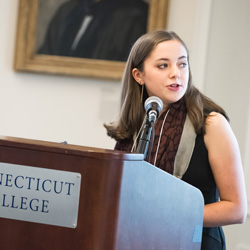
At the recent Mellon Undergraduate Research Symposium, I celebrated a milestone of a year-long process. In front of faculty, staff and fellow students, I gave a presentation driven equally by academic pursuits and personal passion. The process behind the research I presented was one of the most valuable experiences I have gained at Conn thus far.
The Mellon Undergraduate Research Program encourages and sponsors students to pursue research in the arts and humanities. This program enables the existence of sophomore seminars that are centered on this kind of research. In Professor David Jaffe’s “Art of Protest: Occupy ____” sophomore seminar, I learned about how art and protests have historically merged to bring about change. Simultaneously, I explored the impact of contemporary protests through current events and studied the ever-changing definition of what qualifies as protest. “Carry That Weight,” a performance art piece by Columbia University student Emma Sulkowicz, inspired my final project for the class. Emma used art as a medium to protest her alleged rape. I was struck by how this piece allowed Emma to take ownership of her survival, and enabled people to become involved in fighting against sexual assault. I wanted to explore this idea further, so at the end of the semester I took the opportunity to apply for a Mellon grant to support my research. I was lucky enough to be awarded the grant that winter.
My research was conducted through an internship at a child advocacy organization in my hometown that serves child survivors of abuse, neglect and domestic violence. My presentation focused on the findings of two questions. The first: “How does artistic creativity offer a path to protest for abuse survivors?” At my organization, the children found ways to speak out and be heard through art and play therapy, interaction with fellow child survivors, and participation in an organization-wide art project that allowed them to envision a world without abuse.
Second question: “How can I integrate artistic creativity into my skill-set to speak out for causes that matter to me?” I found that the best outlet for my creativity was newsletter-writing, which taught me how to use photos and formatting to appeal to community members. I also learned how to effectively solicit donations. Through creative word choice in speech and writing, I attracted the attention of donors and furthered the organization’s cause.
I hope to integrate these ideas of creativity into my future advocacy work and research; I’m already thinking of ways to incorporate the skills learned from this experience into my junior year internship. Being a Mellon Undergraduate Fellow was an invaluable resource, and I hope the College supports these programs far into the future to enable the innovative research of many more students.